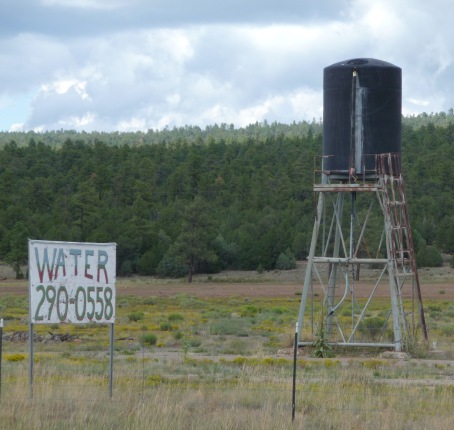
On Highway 53 between Ramah and Grants, N.M.
In 1988 the United States Supreme Court dealt New Mexico a devastating blow. It ruled that since the 1960s the state had been cheating Texas out of 10,000 acre-feet a year of Pecos River water. New Mexico was ordered to pay $14 million in restitution and to make sure that this never happened again. Emlen Hall, a professor emeritus of law at the University of New Mexico, wrote about the saga in High and Dry: The Texas-New Mexico Struggle for the Pecos River, the most interesting book I know about water in the Southwest.
The river begins as a creek funneling snowmelt off the south slope of the Santa Barbara Divide in the Pecos Wilderness northeast of Santa Fe. On its way down the mountains, the Pecos is joined by the Rio de los Chimayosos, which drains the Truchas Peaks, then by Beatty Creek, Jack’s Creek, Panchuela Creek, Winsor Creek, and Holy Ghost Creek. Roaring with water, the stream continues south through Santa Rosa, Fort Sumner, Roswell, and Carlsbad before crossing the Texas state line. Ensuring that there is anything left by then to satisfy Texas has been a legal, political, hydrological, and engineering nightmare.
As recently as 2001, in the depths of the drought, Tom Turney, who was New Mexico’s water czar (the proper title is State Engineer), warned that he might have to make a priority call: upstream users with junior water rights, including the city of Roswell, would have their supply cut off. That was enough to grab the attention of the state legislature: $34 million was appropriated to buy up 18,000 acres of Pecos farmland and take it permanently out of production. To get through the year without incurring penalties, $900,000 was spent to purchase water from the Carlsbad Irrigation District, and thousands of acre-feet of ground water was pumped by the state and dumped into the river.
Given all that effort and expense, it was strange to learn last week from Julie Ann Grimm in the New Mexican that a proposal is still on the table to pump 6,850 acre-feet a year of Pecos water all the way back to Santa Fe, a distance of 450 miles. The entrepreneurs behind the scheme, Berrendo LLC, have been pulling out all the stops. All that new water, they say, would mean more affordable housing and a more reliable, diverse water supply. It would also mean more subdivisions and sprawl. According to the company’s presentation on the Santa Fe City website, Berrendo has the support of Fort Sumner’s mayor and city council and the De Baca County Commission.
When a similar plan was hatched a few years ago to pipe in water from the Estancia Valley, local residents came here to rally in opposition. In Fort Sumner, we’re told, they are eager to get out of the farming and ranching business. Why bother with cattle and alfalfa when you can sell your water at a premium to the city slickers in Santa Fe?
George Johnson
The Santa Fe Review
